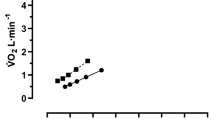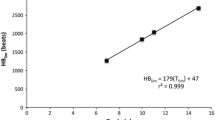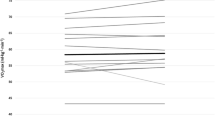Abstract
The purpose of this study was to compare critical velocity (CV) estimates from five mathematical models, and to examine the oxygen uptake \(({\dot{V}}{\rm O}_{2})\) and heart rate (HR) responses during treadmill runs at the five estimates of CV. Ten subjects (six males and four females) performed one incremental test to determine maximal oxygen consumption \(({\dot{V}}{\rm O}_{2\,{\rm max}})\) and four or five randomly ordered constant-velocity trials on a treadmill for the estimation of CV. Five mathematical models were used to estimate CV for each subject including two linear, two nonlinear, and an exponential model. Up to five randomly ordered runs to exhaustion were performed by each subject at treadmill velocities that corresponded to the five CV estimates, and \({\dot{V}}{\rm O}_{2}\) and HR responses were monitored throughout each trial. The 3-parameter, nonlinear (Non-3) model produced CV estimates that were significantly (P < 0.05) less than the other four models. During runs at CV estimates, five subjects did not complete 60 min at the their estimate from the Non-3 model, nine did not complete 60 min at their estimate from the Non-2 model, and no subjects completed 60 min at any estimate from the other three models. The mean HR value (179 ± 18 beats min−1, HRpeak) at the end of runs at CV using the Non-3 model was significantly less than the maximal HR (195 ± 7 beats min−1, HRmax) achieved during the incremental trial to exhaustion. However, mean HRpeak values from runs at all other CV estimates were not significantly different from HRmax. Furthermore, data indicated that mean \(\dot{V}{\rm O}_{2}\) values increased during runs at CV estimates from the third minute to the end of exercise for all models, and that these increases in \(\dot{V}{\rm O}_{2}\) (range = 367–458 ml min−1) were significantly greater than that typically associated with O2 drift (≈200 ml min−1) for all but the exponential model, indicating a \(\dot{V}{\rm O}_{2}\) slow component associated with CV estimates from four of the five models. However, the mean \(\dot{V}{\rm O}_{2}\) values at the end of exercise during the runs at CV estimates for all five mathematical models were significantly less than the mean \(\dot{V}{\rm O}_{2\,{\rm max}}\) value. These results suggest that, in most cases, CV estimated from the five models does not represent a fatigueless task. In addition, the mean CV estimates from the five models varied by 18%, and four of the five mean CV estimates were within the heavy exercise domain. Therefore, CV would not represent the demarcation point between heavy and severe exercise domains.

Similar content being viewed by others
References
Barstow TJ (1994) Characterization of VO2 kinetics during heavy exercise. Med Sci Sports Exerc 26:1327–1334
Billat VL, Richard R, Binsse VM, Koralsztein JP, Haouzi P (1998) The \({\dot{V}}{\rm O}_{2}\) slow component for severe exercise depends on type of exercise and is not correlated with time to fatigue. J Appl Physiol 85:2118–2124
Billat VL, Blondel N, Berthoin S (1999) Determination of the velocity associated with the longest time to exhaustion at maximal oxygen uptake. Eur J Appl Physiol 80:159–161
Billat VL, Morton RH, Blondel N, Berthoin S, Bocquet V, Koralsztein JP, Barstow TJ (2000) Oxygen kinetics and modeling of time to exhaustion whilst running at various velocities at maximal oxygen uptake. Eur J Appl Physiol 82:178–187
Bull AJ, Housh TJ, Johnson GO, Perry SR (2000a) Effect of mathematical modeling on the estimation of critical power. Med Sci Sports Exerc 32:526–530
Bull AJ, Housh TJ, Johnson GO, Perry SR (2000b) Electromyographic and mechanomyographic responses at critical power. Can J Appl Physiol 25:262–270
Carter H, Pringle JSM, Jones AM, Doust JH (2002) Oxygen uptake kinetics during treadmill running across exercise intensity domains. Eur J Appl Physiol 86:347–354
deVries HA, Moritani T, Nagata A, Magnussen K (1982) The relation between critical power and neuromuscular fatigue as estimated from electromyographic data. Ergonomics 25:783–791
Gaesser GA, Poole DC (1996) The slow component of oxygen uptake kinetics in humans. In: Holloszy JO (ed) Exercise and sport sciences reviews. Williams & Wilkins, Baltimore, pp 35–70
Gaesser GA, Carnevale TJ, Garfinkel A, Walter DO, Womack CJ (1995) Estimation of critical power with nonlinear and linear models. Med Sci Sports Exerc 27:1430–1438
Hill DW, Ferguson CS (1999) A physiological description of critical velocity. Eur J Appl Physiol 79:290–293
Hopkins WG, Edmund IM, Hamilton BH, MacFarlane DJ, Ross BH (1989) Relation between power and endurance for treadmill running of short duration. Ergonomics 32:1565–1571
Housh DJ, Housh TJ, Bauge SM (1989) The accuracy of the critical power test for predicting time to exhaustion during cycle ergometry. Ergonomics 32:997–1004
Housh TJ, Johnson GO, McDowell SL, Housh DJ, Pepper M (1991) Physiological responses at the fatigue threshold. Int J Sports Med 12:305–308
Housh TJ, Johnson GO, McDowell SL, Housh DJ, Pepper M (1992) The relationship between anaerobic running capacity and peak plasma lactate. J Sports Med Phys Fit 32:117–122
Housh TJ, Cramer JT, Bull AJ, Johnson GO, Housh DJ (2001) The effect of mathematical modeling on critical velocity. Eur J Appl Physiol 84:496–475
Hughson RL, Cook CJ, Staudt LE (1984) A high velocity treadmill running test to assess endurance running potential. Int J Sports Med 5:23–25
Jenkins DG, Quigley BM (1990) Blood lactate in trained cyclists during cycle ergometry at critical power. Eur J Appl Physiol 61:278–283
Jenkins DG, Quigley BM (1992) Endurance training enhances critical power. Med Sci Sports Exerc 24:1283–1289
Kranenburg KJ, Smith DJ (1996) Comparison of critical speed determined from track running and treadmill tests in elite runners. Med Sci Sports Exerc 28:614–618
McDowell SL, Kenney KB, Hughes RA, Housh TJ, Johnson GO (1988) The relationship between ventilatory threshold and critical velocity. Abstracts of Research Presentations at the National AAHPERD Convention. AAHPERD Publications, Kansas City, p 155
Monod H, Scherrer J (1965) The work capacity of a synergistic muscular group. Ergonomics 8:329–338
Moritani T, Nagata A, deVries HA, Muro M (1981) Critical power as a measure of physical work capacity and anaerobic threshold. Ergonomics 24:339–350
Morton RH (1996) A 3-parameter critical power model. Ergonomics 39:611–619
Pepper ML, Housh TJ, Johnson GO (1992) The accuracy of the critical velocity test for predicting time to exhaustion during treadmill running. Int J Sports Med 13:121–124
Poole DC, Ward SA, Gardner GW, Whipp BJ (1988) Metabolic and respiratory profile of the upper limit for prolonged exercise in man. Ergonomics 31:1265–1279
Poole DC, Barstow TJ, Gaesser GA, Willis WT, Whipp BJ (1994) \({\dot{V}}{\rm O}_{2}\) slow component: physiological and functional significance. Med Sci Sports Exerc 26:1354–1358
Whipp BJ (1994) The slow component of O2 uptake kinetics during heavy exercise. Med Sci Sports Exerc 26:1319–1326
Author information
Authors and Affiliations
Corresponding author
Rights and permissions
About this article
Cite this article
Bull, A.J., Housh, T.J., Johnson, G.O. et al. Physiological responses at five estimates of critical velocity. Eur J Appl Physiol 102, 711–720 (2008). https://doi.org/10.1007/s00421-007-0649-7
Accepted:
Published:
Issue Date:
DOI: https://doi.org/10.1007/s00421-007-0649-7




